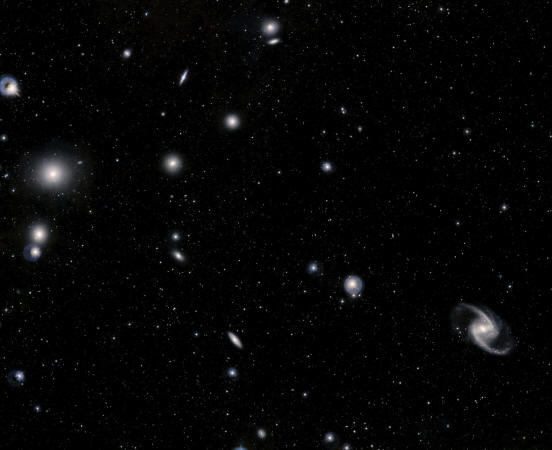Hide and Seek
Mar 30, 2010
Astronomers claim to have found
the galaxies missing in their
earlier observations.
“Astronomers always knew they were
missing some fraction of the
galaxies in Lyman-alpha surveys, but
for the first time we now have a
measurement. The number of missed
galaxies is substantial.” So states
Matthew Hayes in a recent
press release from the
European Southern Observatory (ESO)
in Paranal, Chile.
According to ESO, astronomers
have not been able to see most of
the light from what they call "the
earliest days of the Universe"
because specific frequencies that
are used in their surveys are
absorbed by the galaxies emitting
them. Therefore, their galaxy counts
are most likely off by a significant
factor. What that factor is has not
been known until now, ESO
investigators claim.
The hydrogen atom is composed of
one electron orbiting a single
proton. That one proton forms the
hydrogen atom's nucleus. Since a
proton's mass is 1836 times greater
than an electron, the majority of a
hydrogen atom's mass is contained in
the nucleus. Quantum physics states
that an electron's orbit must abide
by a wave function that fits into
its orbital circumference: the “principal
quantum number.”
Mathematical calculations use the
value n = 1 for the smallest radius,
with n = 2, n = 3, and so on as the
orbit increases. Those radii must
also rise and fall in discrete
steps.
As quantum mechanics theory
posits, since electrons are
negatively charged they are
attracted to nuclear protons by a
force called "binding
energy." Each "n" orbit
possesses its own binding energy
value expressed in "electron
volts." The closer the
electron is to a hydrogen atom's
proton nucleus, the greater the
binding energy. As an electron jumps
from an orbit with a lower binding
energy to an orbit with greater
energy (n2 to n1 for example), it
emits light at a specific
ultraviolet frequency. Light from
the n2 to n1 jump corresponds to
121.6 nanometers and is called
"Lyman-alpha" radiation, named for
Theodore Lyman, who first
discovered it in 1906.
Astronomers use detectors
sensitive to the Lyman-alpha
frequency to count distant stars.
However, stellar surveys using
Lyman-alpha light waves see only
part of the starlight because
Lyman-alpha ultraviolet is blocked
by interstellar dust clouds. The ESO
team claims to have overcome that
difficulty by re-scanning the sky in
another frequency of hydrogen light
called H-alpha. H-alpha is emitted
when electrons make the jump from n3
to n2, corresponding to 656
nanometers, or infrared light.
Infrared is less readily absorbed by
intervening gas and dust.
Since reviewing so-called "deep
field" surveys in H-alpha light, 90%
more stars have been detected than
were previously seen in the
Lyman-alpha band. Said ESO team
member and co-author Miguel
Mas-Hesse: “Now that we know how
much light we’ve been missing, we
can start to create far more
accurate representations of the
cosmos, understanding better how
quickly stars have formed at
different times in the life of the
Universe.”
Could these new insights prove
detrimental to the theory of dark
matter?
Astronomers first postulated a
dark form of matter when they found
that stars near the edge of spiral
galaxies revolve at the same angular
speed as stars closer to the center.
According to Newtonian mechanics
stars farther away from the center
should be moving more slowly.
Therefore, astronomers assumed dark
matter, not observable by current
instruments, was imparting extra
speed to the stars.
The gravitational force exerted
by this unseen and undetectable
material is said to sustain not just
our galaxy, but all galaxies.
Conventional theories propose that
the "big bang" brought all matter
and energy into existence, including
dark matter. Every modern
cosmological theory has the big bang
at its core. For many years,
investigators tried to reconcile the
lack of mass, particularly in galaxy
clusters, with the expansion of the
Universe and the acceleration of
that expansion.
It has been stated many times in
these pages that dark matter is an
unnecessary theory if electrical
phenomena are taken into account.
Stellar ages and the "age of the
Universe" are also seriously
compromised when astronomical
investigations presuppose that their
images represent objects whose
H-alpha emissions have been
traveling through the cosmos for 10
billion years. Big bang cosmology
sets modern science on a path that
leads to misapprehension.
Electric Universe theory sees
galaxies and their associated stars
being driven by electric currents
flowing through dusty plasma over
immeasurable distances.
Birkeland currents create
z-pinch compression zones
between spinning magnetic fields.
The compressed ions form spheres of
glowing plasma, some in arc mode,
some in glow mode and some with
variability between the two states.
Circuits of electricity pouring into
them from outside power the stars
and galactic wheels. In that case,
what should we expect to see in
their shapes and behavior?
Around the galaxies will be
slowly fluctuating Birkeland
filaments, causing mass density
variations that might be interpreted
as gravitational effects.
Intergalactic plasma will create
magnetic fields as the current
flows, interconnecting each galaxy
with its neighbor and forming
electrical bridges between them.
Double layers will form in the
plasma as electric charges isolate
themselves from one another. They
may break down if too much current
flows in the circuit, causing
intense discharges commonly called
"supernovae." Around the galaxies
will be toroids, or rings of charged
plasma, that shine in extreme
ultraviolet, X-ray, and gamma ray
light.
Electron orbit jumps are most
likely due to electric effects. If
astronomers would consider the
forces that affect electric currents
flowing through interstellar plasma
and how those forces are expressed,
they would not now be searching for
what has already been hiding in
plain sight.
Stephen Smith







